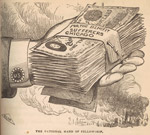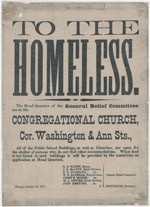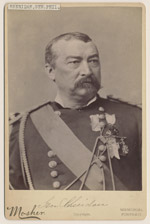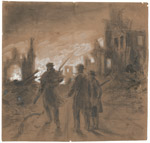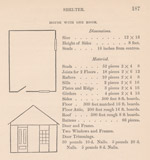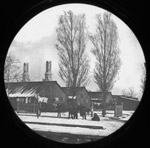Rescue and Relief
This city never was, and probably never will be again, so thoroughly guarded and watched with so many anxious eyes, as it was on that fearful Monday and the few succeeding days.
Fire Narrative of Charles C. P. Holden
Chicago Mayor Roswell B. Mason reached the Court House about midnight, and for as long as he dared he remained in this command post. He followed the fire's progress, issued orders, and telegraphed officials in other cities beseeching them for help. Finally forced to flee the burning building, he became one more frightened fugitive. His goal was just to go home, which was not far to the south. The fire spared his house, though the flames forced him to detour to the north before he could circle back around. His nightmare journey took almost three hours.
On Monday morning, with the city still ablaze, Common Council President Charles C. P. Holden called a group of elected officials and prominent citizens to a meeting that afternoon at the First Congregational Church, out of harm's way on Washington Street in the West Division. These men turned the church into a temporary city hall--the first of several makeshift provisions for government services--and arranged to enlist volunteer special deputies, as well as to provide food and water to the burned-out. After arriving at the meeting, Mayor Mason signed a proclamation pledging "the faith and credit of the city of Chicago" to "the preservation of order,...the relief of suffering," and "the protection of property." Other executive directives set the price of bread, banned smoking, limited the hours of saloons, and forbade wagon drivers from charging more than their normal rates.
This makeshift group of leaders also established a Relief Committee, with representatives from each of the three divisions. The committee's task was to organize and administer the distribution of food, supplies, and money that, thanks to the telegraphed reports of Chicago's distress, began arriving that evening. Contributions eventually totaling about five million dollars in value came from towns and cities across the nation and the world.
Given the appalling circumstances, these first steps seem admirably clear-headed and practical. But to those who felt that the dying out of the flames hardly meant the end of danger, they were not enough. In the wake of the stories of looting, drinking, and arson while the city was burning came reports that professional thieves from elsewhere and local low-life were now eager to prey on weakened Chicago. "The city is infested with a horde of thieves, burglars, and cut-throats, bent on plunder, and who will not hesitate to burn, pillage, and even murder, as opportunity may seem to offer to them to do so with safety," warned the Chicago Evening Journal a day after the fire. The national press carried similar stories, which also appeared in personal accounts. Cassius Milton Wicker, a freight agent for the Chicago and Northwestern railroad, wrote to his family in Vermont, "With the close of the fire, or rather conflagration, our troubles have not closed. Roughs and thieves from all parts of the country flocked here for plunder."
This kind of fear and paranoia invariably follows any large-scale cataclysm, and how much truth was behind the anecdotes is one of the many things about the fire that is impossible to ascertain. Virtually all the reports were based not on personal observation but on hearsay, and it is likely that people like Wicker got their information from reading unsubstantiated stories in the papers. But there is no question the fears that generated and sustained the rumors were real, especially for more prosperous and native-born Chicagoans. In their eyes, what was immediately required was the assertion of a kind of authority that would protect them and their Chicago. At the same time, however, they had little trust in local government, particularly the members of the Common Council. The fire was all too reminiscent of the Paris Commune, which had been put down in late May of 1871 in a bloody battle that ended with Paris set afire by radicals in a last-ditch act of defiance against the Versailles government. Closer to home, the exposure of how Boss Tweed corrupted New York bolstered prejudices against urban political organizations generally.
In this context Mayor Mason followed the urging of the city's social and economic elite by taking two extraordinary steps to ensure the rescue and relief of Chicago. On October 11 he officially entrusted the "preservation of the good order and peace of the city" to Lieutenant-General Philip Sheridan, the Civil War hero and Indian fighter who now lived in Chicago, from which he commanded the United States Army's Division of the Missouri. Two days later Mason turned over the administration of the relief to the Chicago Relief and Aid Society, which had appealed to him to take this step. On the Society's board sat some of the Old Settlers who had established the organization two decades earlier, but its driving spirit was a younger group of businessmen and professionals that included merchant Marshall Field, sleeping car manufacturer George Pullman, and attorney Wirt Dexter. These men had a very substantial stake in the city's future and an equally firm belief that this future depended on reestablishing the social and economic order that they believed had been severely shaken by the the fire.
For two weeks Sheridan oversaw a de facto martial law of dubious legitimacy implemented by a mix of regular troops, militia units, police, and a specially organized "First Regiment of Chicago Volunteers." They patrolled the streets, guarded the relief warehouses, and enforced curfews and other regulations. John DeKoven, cashier of the Merchants' National Bank of Chicago, wrote to his wife of his experience as a sentry, "I have not had my clothes off for a week, the city is pa[t]roled every night, you should have seen me last night pa[t]roling our alley with a loaded revolver in my hand looking for incendiaries for there are many about." Illinois Governor Richard Oglesby, among others, strongly questioned whether such measures were justified and legal, but the calming effect of Mason's actions in the days right after the fire was evident, especially among the well-to-do. Former Lieutenant-Governor William Bross, part owner of the Tribune, later recollected his response to the arrival of Sheridan's soldiers: "Never did deeper emotions of joy overcome me. Thank God, those most dear to me and the city as well are safe."
The Relief and Aid Society's fire activities were considerably more long-lived, extending into 1874. Dividing the city into districts, the Society opened offices and supply depots connected by telegraph. It separated its work into different areas--contributions, shelter, employment, transportation, distribution, and health--each overseen by a designated committee. The Society not only distributed food and clothing, but also made available the materials for several thousand simple "shelter houses," erected four barracks in different places throughout the city for the homeless poor, helped secure necessary tools and appliances to skilled workers, and vaccinated tens of thousands of Chicagoans against smallpox. Its work was a model of a new kind of "scientific" charity, conducted by paid professionals carrying out the policies of an executive board.
These policies reflected the board members' particular vision of what was best for the city. Concerned about losing members of the labor force, they soon suspended the practice of issuing free railroad passes out of Chicago to those who had been burned out. Similarly, they took better care of some members of the population than others. For example, the shelter houses were reserved mainly for workers the Society was particularly eager to keep in rebuilding Chicago, such as carpenters. The Committee on Special Relief looked to the needs of those more genteel fire victims who "were borne in a single night from homes of comfort and plenty into absolute destitution." It was assumed that people of refinement would have to be found and helped discreetly, since they would be too proud to ask for help.
As for the able-bodied poor, the barracks were good enough--probably better, the Society maintained, than the housing they had lost. And the main goal was to get them off relief as soon as possible. The Society took great care "to detect and defeat imposition" by such people and "to aid in establishing order by withholding encouragement to idleness," which was a threat to social order. A key policy was to "give no aid to any families who are capable of earning their own support." Applicants for aid were required to fill out various forms and provide a reliable reference, such as an employer or minister. Then a "visitor" would check personally on the merits of the case. A labor exchange was set up, and the Society soon claimed that "any man, single woman, or boy, able to work, and unemployed at this time, is so from choice and not from necessity."
The Relief and Aid Society deserves a great deal of credit for its extraordinary efforts. Its board served without pay, and they probably did dispense the world's charity more effectively than Chicago's overburdened and underfinanced post-fire city government would have done. But the warnings of the danger of entrusting the funds to local officials were exaggerated by concerns about the balance of power in a democracy defined by class and ethnicity (the Society took care to identify its clients by national origin). Journalist Sydney Howard Gay, who later wrote the Society's self-congratulatory report on its work following the fire, claimed that its leaders were men "above personal temptation" who saved the relief from "the utter corruption of our city politics." The alternative, the Tribune agreed, was "the foul brood of city politicians who greedily "counted...upon retaining place and putting their enemies under their feet, with the personal and pecuniary power which the handling of the relief fund and provisions in kind would give them."
Meanwhile, some applicants for help grumbled about inefficiency, impersonality, and favoritism. In late February of 1872, the Society terminated assistance to some eight hundred families on the grounds that they were now the responsibility of the financially-strapped county government. Critics complained that this denied aid to the needy in the dead of winter, and that only the Relief and Aid Society had the resources to help, resources that were given not to it but to the people of Chicago. Common Council President Holden proposed that the Society be foreced to hand over the remaining relief funds to the city. The proposal failed, and the consensus among the most influential remained that the Society, like Sheridan and his soldiers, had saved Chicago in its hour of desperation, when its own worst enemy was perhaps itself. "In the midst of the most pressing demands of their private affairs," Frederick Law Olmsted told readers of The Nation, "men of great good sense and well informed have taken time to devise and bring others into a comprehensive and sufficient organization, acting under well-guarded laws."
